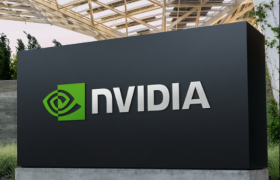Can NVIDIA Keep Up with Itself?

NVIDIA (Nasdaq: NVDA) posted record earnings for its first fiscal quarter of 2025 last night, amid questions about whether the company can keep pace with demand while fending off growing competition.
NVIDIA reported $26 billion in quarterly revenue, up 18% sequentially and 262% year-on-year (y/y)—and beating the company’s own $24 billion forecast. Of total sales, $22.6 billion came from NVIDIA’s Data Center division revenue, which rose 23% from last quarter and 427% y/y. Adjusted net income was $15.2 billion, up 462% y/y, and EPS was $6.12, up 461%.
All this growth helped fuel a 150% rise in the company’s quarterly cash dividend and inspired a ten-for-one forward stock split of NVIDIA’s common stock, to take effect June 6 and 7, 2024, with trading commencing on June 10. Following the release of the news, NVIDIA shares were up 10% in midday trading, breaking the $1,000 per share mark for the first time and reaching an all-time high of $1,045 as of this writing.
Data Center Leads, Supply Is an Issue
Sales from NVIDIA’s Data Center division accounted for over 87% of total revenue this quarter. And within that Data Center revenue figure, computing products (NVIDIA’s Hopper GPUs), accounted for $19.4 billion (about 86%), up 29% sequentially and 478% y/y.
Networking, the other portion of Data Center sales, reported $3.2 billion (14% of DC sales total), up 242% y/y but down 5% sequentially. Management attributed the reduction to the timing of supply, which they said should return to normal and show growth this quarter.
Indeed, supply timing appears to be an issue throughout NVIDIA’s Data Center product line, with management acknowledging trouble keeping up with demand. During the company’s conference call, CEO and co-founder Jensen Huang said NVIDIA is “racing” to meet orders. Even the new Blackwell chip, which is in production but not yet shipping in full force, shows demand ahead of supply. And that situation will continue well into next year, management said.
Who’s Ordering It All?
Demand for NVIDIA datacenter products is coming not just from the large hyperscalers—Microsoft, Google, AWS, Meta, and Oracle, which accounted for about a “mid-40s” share of Data Center revenue—but from enterprises across a range of verticals.
“Our data center growth was fueled by strong and accelerating demand for generative AI training and inference on the Hopper platform,” said Huang in a published statement. “Beyond cloud service providers, generative AI has expanded to consumer internet companies, and enterprise, sovereign AI, automotive and healthcare customers, creating multiple multibillion-dollar vertical markets.”
Notably, NVIDIA said automotive is its largest enterprise customer vertical market for Data Center products, with Tesla leading the roster. That company ordered tens of thousands of H100 GPUs to help develop software for self-driving cars last quarter.
And enterprise isn’t the only segment clamoring for NVIDIA AI products. Governments around the world, Huang said, are looking to develop “sovereign” AI networks in combination with local telcos and other service providers. He cited a range of examples on last night’s call, including Japan, France, and Italy.
Challenges Loom
Amid all the good news, investors have questions about whether NVIDIA has a handle on its supply stream. How can it be sure companies aren’t stockpiling chips, for instance? Huang fielded a question on that by reiterating the enormous demand, which led to more questions about whether customers themselves can keep pace with NVIDIA’s aggressive rhythm of chip delivery. After all, not everyone’s budgets are like those of Tesla or the hyperscalers.
And competition is increasing as NVIDIA races to keep up with orders. AMD, Intel, and a range of startups such as Groq, are creating chips to compete with NVIDIA. Many target inference, the next step up from training large language models (LLMs), in which data is fed to models to produce information. Indeed, NVIDIA reported that inference drove 40% of Data Center revenue last quarter.
While these and other challenges face NVIDIA, its stunning growth speaks to the persistence of the AI trend. Even given the marketing bubble that’s followed the initial push into AI last year, there’s evidence that the technology is an immutable industry force. Still, how that will play out for enterprise customers, and whether NVIDIA can keep up with itself, remains to be seen.
Futuriom Take: NVIDIA continues to lead a major technological shift toward AI. But its growth will likely be tempered by supply constraints, competition, and enterprises’ inability to afford its aggressive innovation cycle.















